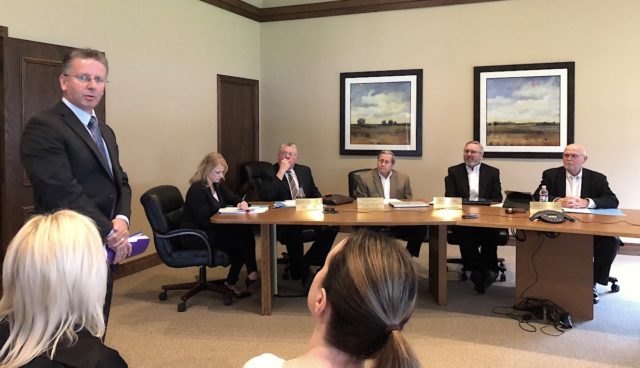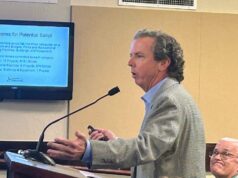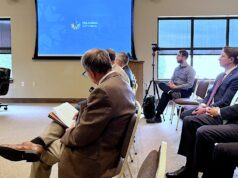

On the heels of COVID-19’s cost-increasing impacts on the health care system, OU Health is in the process of obtaining $150 million of tax-exempt financing through the Oklahoma Development Finance Authority in an effort to improve liquidity, finance a series of operational investments and rectify a capitalization concern that led to a bond rating downgrade earlier this year.
ODFA board members unanimously approved the first chunk of that financing this morning: a $50 million loan from Bank of America Public Capital Corporation that will be secured by equipment owned by OU Health. ODFA is serving as a “conduit” for the tax-exempt loan, which an OU Health official said comes with more regulations — such as using a conduit entity — and a lower interest rate.
“It’s eligible, and it’s cheaper,” said Jerome Houizot, vice president of treasury for OU Health.
Mike Davis, ODFA director, said the rate for the Bank of America loan will be 3.88 percent over seven years.
“ODFA is performing its roll as the conduit,” Davis told his board. “There is no credit liability for [ODFA] or the state of Oklahoma.”
As ODFA board members considered the $50 million loan request, Houizot said he would be back in about a month to request approval of another $100 million loan.
That financing would be backed by the revenues of OU Health, which was created in 2021 as the state’s first fully integrated academic health center.
“Today we have to face additional expenses, and it’s just to reconfigure the plan that we initially forecasted, and it’s also a way to recapitalize our balance sheet,” Houizot said.
Background on OU Health, bond rating
OU Health is the new branding of OU Medicine Inc., which completed a buyout of Hospital Corporation of America in 2018. As part of that transaction — which eliminated third-party management of the OU health system — ODFA also approved conduit financing. (Davis said that financing also supported the construction of a new 172-bed hospital tower at the Oklahoma City campus.)
Houizot joined OU Health in January 2018, and after Wednesday’s meeting he described the investments in patient care being made currently: CT scan, MRI and cardiovascular intensive care unit expansions are expected to become operational before the end of June.
Such investments are expected to help boost revenue in the long run, and he said OU Health’s $1.9 billion in annual revenue right now is not the issue when it comes to the health system’s financial picture.
“It’s not so much revenue, I would say. Two years ago, no. But right now, it’s in line with what we projected,” Houizot said. “The main issue we are having — we’re not the only one in this case — it’s contract labor. Traveling nurses, basically. It’s out of the roof across the nation, and we are not different from other health systems.”
At one point during the pandemic, OU Health was paying an hourly rate of $185 for nurses, though he said that figure has dropped some.
“Before COVID, it was very minimal,” he said of OU Health’s contract labor costs. “But today, you can see right now in our financials after six months, we are at $79 million for six months, which is huge.”
Those costs have eaten up cash reserves and have limited the health system’s liquidity. Houizot said that played a factor in the March announcement by the financial services company Moody’s that it had downgraded OU Health’s bond rating from Baa3 to Ba2 in March.
“The main point for Moody’s with the downgrade, it was liquidity. Liquidity comes from two things: your financial performance and your capital,” Houizot said. “Your contract labor doesn’t help your financial performance, and on top of that we are going through the [electronic health records] implementation.”
He said the $50 million and $100 million lines of financing will help address the concerns identified by Moody’s.
“We are basically structuring and financing and liquidity long term so it’s more solid, versus trying to fight over other options,” Houizot said.
From the March 23 bond downgrade announcement by Moody’s:
The magnitude of the downgrade to Ba2 reflects projected cashflow in fiscal 2022 that will be materially below prior expectations, from an escalation of labor costs, and reliance on a financing to avoid a further decline in already weak liquidity and potential covenant breach. Also, the rating action reflects execution risk given a prolonged period of management turnover with several key positions unfilled or filled with interim leaders, a governance consideration under Moody’s ESG classification. Staff shortages will constrain the system’s ability to fully recover from the pandemic and meet high patient demand following the completion last year of a major facility expansion to alleviate capacity issues. OUH will be evaluating financing options to provide liquidity and avoid a covenant breach. The rating continues to reflect OUH’s high leverage following its buyout from HCA in 2018 and high competition from other healthcare systems and physician-owned facilities in the absence of Certificate of Need regulations.Despite these significant challenges, the rating favorably incorporates the potential for financial assistance from several closely affiliated public bodies, which would slow the decline in cash and/or help avoid a covenant breach and event of default. The system’s unique ties to the State of Oklahoma through The University Hospitals Trust (the Trust), OUH’s sole corporate member and a public body with state board representatives, will continue to facilitate large and growing supplemental reimbursement. Additionally, the Trust’s financial resources and commitment to OUH’s mission indicate an ongoing willingness and ability to support the system, including providing grants for capital projects and temporary liquidity for cashflow management. An additional source of liquidity could be sizable state grants for strategic capital projects, if approved later this year. Although not obligated on OUH’s bonds, the system also benefits from close clinical and financial affiliations with the University of Oklahoma Health Sciences Center (University) and the OU Foundation, the latter of which has a financial interest in OUH as a lender.
Houizot explained the details of that final line regarding the OU Foundation having a financial interest in OU Health.
“Indeed, we have subordinated debt with the OU Foundation,” he said. “OU Foundation is a lender to OU Health.”
Houizot said OU Health (at the time, OU Medicine) took out a $135 million loan in 2018. The 14-year loan has a 5 percent interest rate, he said.
“It was to basically capitalize OU Medicine in the balance sheet at the time we started to operate,” he said. “When OU Medicine started, remember we started from scratch. So we issued debt to acquire the assets from HCA. But we needed also cash, basically, for the operation.”
Another OU Health official provided a broader statement about the organization’s financing sought before the ODFA.
“OU Health intends to take advantage of the current historically low interest rates by financing investments in capital upgrades to several patient care areas across the health system and equipment upgrades for the new Electronic Health Record, totaling $150 million,” said Jennifer Schultz, senior vice president for marketing and external relations for OU Health. “The financing is a reconfiguration of a long-term business plan that was developed in 2017, in order to respond to the changing health care environment due to the impact of COVID-19. $50 million of the financing is a private placement and secured asset financing between OU Health and Bank of America, not a public revenue bond. $100 million of the financing will be long-term revenue bonds which are guaranteed by OU Health’s $1.9 billion annual patient revenue.”




















